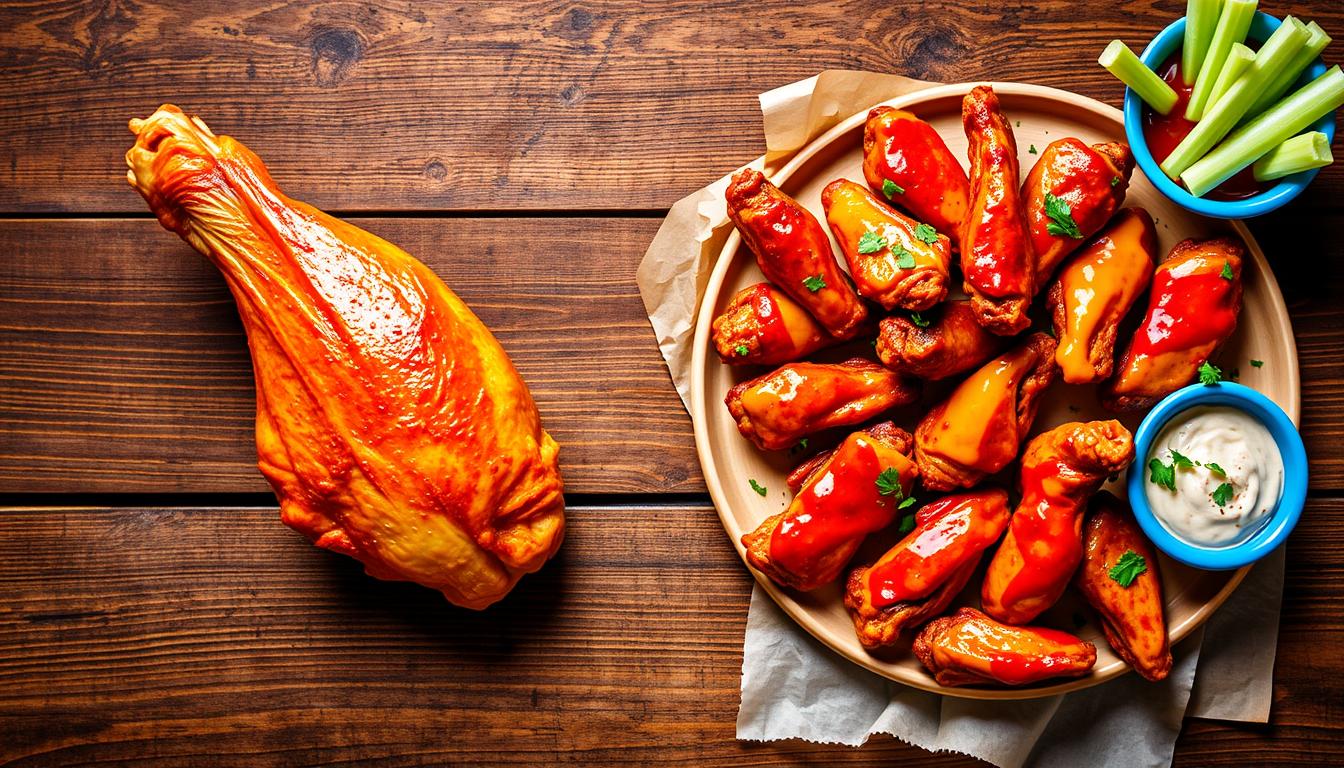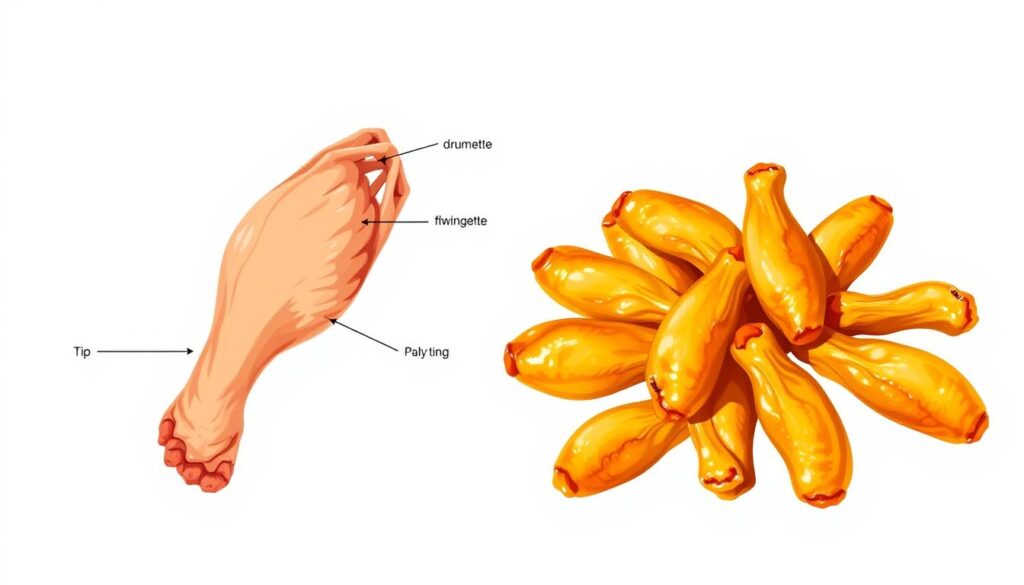Chicken wings are a favorite in many homes and restaurants in the U.S. They can be made in many ways, from Buffalo-style to new flavors. But, many people get confused about the difference between whole wings and party wings.
A whole wing, also known as a “jumbo” or “regular” wing, is the whole wing from a chicken. It has the drumette, wingette (or flat), and wing tip all together. On the other hand, party wings, or “wing segments,” are the pieces that have been cut and separated.
Key Takeaways
- Whole wings are the complete, uncut wing from the chicken, while party wings are the pre-cut individual pieces.
- Whole wings are typically cheaper than party wings, as the cutting process adds an extra cost.
- With a sharp knife and some practice, you can easily cut whole wings into party wings at home, saving money.
- Understanding the anatomy of a chicken wing can help you make the best choice for your cooking needs.
- Proper storage and cooking methods are important for ensuring the safety and quality of your chicken wings.
Understanding Chicken Wing Anatomy
Chicken wings are a favorite dish, but do you know their parts? A chicken wing has three main parts: the drumette, the wingette (also known as the “flat”), and the tip. Knowing these parts can enhance your wing-eating experience.
The Three Main Parts of a Wing
- The drumette is the meatiest part, looking like a small drumstick with lean white meat.
- The wingette (or “flat”) is the middle section, with richer dark meat between two bones.
- The tip has very little meat and is mostly skin and bones, often used for making stock.
Chicken wings have both white and dark meat. The drumette and wingette offer different textures and flavors. Knowing these parts helps you enjoy wings perfectly.
Wing Tip (Flapper)
The wing tip, also known as the “flapper,” is the smallest and least meaty part. It has thin skin and little flesh. The tip is often used for making chicken stock or broth, adding flavor.
Wingette (Flat) and Drumette
The wingette, or “flat,” is the middle section with two bones and tender, juicy dark meat. The drumette is the meatiest part, looking like a small drumstick with white meat.
These two sections have different textures and cooking times. Wingettes may need longer cooking times because of their size. Drumettes cook faster because they are smaller.
What is the Difference Between a Whole Wing and a Party Wing?
When buying chicken wings, you can choose between whole wings and party wings. Knowing the differences helps you pick the right one for your cooking and budget.
Whole wings are the full wing, with the wingette, drumette, and wing tip. They’re great because you can cook them whole or cut them up.
Party wings are already cut into wingette and drumette pieces. They’re quicker to cook but cost more per pound than whole wings.
Choosing between whole and party wings depends on what you like and what you’re making. Whole wings are customizable and save money. Party wings are quicker but pricier.
- Whole wings are the complete, uncut wing, including all three parts.
- Party wings are pre-cut into separate wingette and drumette pieces.
- Whole wings offer more versatility but may require additional preparation time.
- Party wings are more convenient but often more expensive per pound.
Think about your cooking style, the recipe, and your budget when picking chicken wings. Both whole and party wings have their benefits. Pick the one that fits your needs and taste.
Cost Comparison: Whole Wings vs Party Wings
Choosing between whole wings and pre-cut party wings can save you money. Knowing the price difference is key for those watching their budget.
Price Differences per Pound
Whole wings are 30 to 70 cents cheaper per pound than party wings. Whole wings cost between $2.58 and $3.35 per pound. Party wings range from $1.99 to $2.74 per pound.
Budget Benefits of Buying Whole Wings
- Cutting whole wings yourself can save a lot, especially for big events.
- Whole wings are cheaper if you’re willing to spend time preparing them.
- By cutting wings at home, you can control portions and reduce waste, saving even more.
In summary, whole wings are the better deal compared to party wings. Cutting them yourself can lead to big savings. This way, you can make your budget go further.
How to Properly Cut Whole Wings into Party Wings
Cutting whole chicken wings into individual party wings is easy and can save you money. It also makes meal prep more versatile. You can turn whole wings into drum-like drumettes and flat-shaped wingettes. These are great for appetizers, game-day spreads, or any DIY chicken wing recipe.
To cut whole wings right, find the joints that connect the three main parts. These are the drumette, the wingette (also called the “flat”), and the wing tip (or “flapper”). Use a sharp knife to make two cuts to separate these parts.
- Flip the whole wing skin-side down to clearly see the joints.
- Identify the joint between the wingette and the wing tip. Make a clean cut through this joint to remove the wing tip.
- Next, locate the joint between the drumette and the wingette. Make another cut through this joint to separate the drumette from the wingette.
With a bit of practice, cutting through the joints quickly becomes easy. In fact, you can prepare about 2 pounds of wings in just 2 minutes. The resulting drumettes and wingettes are now ready to be seasoned, baked, fried, or prepared in any way you choose for your DIY chicken wing party.
Remember, the wing tips you remove can still be used to make delicious chicken stock or broth. So don’t let those little bits go to waste!
By mastering the art of cutting whole wings into party wings, you’ll not only save money but also have the flexibility to create a wide variety of wing dishes at home. Get ready to impress your guests with your wing preparation skills!
Essential Tools for Cutting Chicken Wings
Preparing delicious chicken wings requires the right tools. You need the right knife and a clean cutting board. Each tool is crucial for safe and efficient wing cutting.
Choosing the Right Knife
A sharp chef’s knife or sturdy kitchen shears are best for cutting wings. These wing cutting tools help you cut the wings neatly. You can easily separate the tips, wingettes, and drumettes.
Cutting Board Selection
Use a plastic cutting board for kitchen safety when cutting raw meat. Wooden boards can harbor bacteria, so they’re not safe for cutting meat.
Safety Equipment
- Wear cut-resistant gloves for extra protection while cutting wings.
- Keep your work area well-lit and free from distractions to avoid accidents.
With the right tools and safety measures, you can cut chicken wings safely and efficiently. This lets you prepare tasty dishes with confidence.
Restaurant Standards for Wing Portions
Ordering chicken wings means knowing the standards for wing portion sizes. This helps you make smart choices and compare prices at different restaurants.
In the restaurant wing servings world, each flat or drum is counted as “1 wing.” So, a full wing, with both parts, is seen as two wing portions. But, some restaurants might serve whole wings as one serving.
- At Buffalo wing places, wings are usually counted as individual flats or drumettes.
- Fried chicken restaurants with many chicken parts might offer whole wings as a special item.
- Knowing these wing portion standards helps you compare prices and make good choices when eating out.
Being aware of these norms helps you navigate the chicken wings world. You’ll get the portion size and value that fits your taste.
Whether you love wings or just enjoy them sometimes, knowing the restaurant standards for wing portions makes your dining better. It helps you choose wisely when ordering this favorite dish.
Storage and Preservation Tips
Keeping chicken wings fresh and safe is key. Whether they’re raw or cooked, the right storage tips are crucial. They help keep your wings fresh longer and cut down on waste.
Refrigeration Guidelines
Raw, cut chicken wings need to be in an airtight container in the fridge until the expiration date. Cooked wings can stay in the fridge for 3-4 days. Always handle and store chicken safely to avoid contamination.
Freezing Methods
- Freeze raw chicken wings in airtight bags or containers for long-term storage. They’ll last for months.
- Freeze wing tips for making tasty chicken stock. Store them separately.
Using the right storage methods, whether in the fridge or freezer, is vital. It keeps your chicken wings fresh and safe. This also helps reduce waste.
“Preserving the freshness and quality of your chicken wings is key to enjoying them at their best. With the right storage methods, you can extend their shelf life and minimize food waste.”
| Storage Method | Refrigerator (40°F or below) | Freezer (0°F or below) |
|---|---|---|
| Raw Chicken Wings | 1-2 days | 8-12 months |
| Cooked Chicken Wings | 3-4 days | 2-3 months |
By sticking to these wing preservation tips, your chicken wings will stay fresh. Enjoy them whenever you want.
Cooking Methods for Different Wing Types
There’s no single way to cook chicken wings. The method you choose affects the wings’ texture and taste. Whether you like them crispy, juicy, or a mix, knowing each technique helps make perfect wings.
Baked Wings
Baking is a healthier choice than deep-frying. But, it needs some tricks for crispy skin. Dry the wings with paper towels, then coat with olive oil and seasonings. Bake at 400°F for 30-35 minutes, flipping once.
For even crispier wings, raise the oven to 435°F for the last 5 minutes.
Deep-Fried Wings
Deep-frying gives you the crispiest wings. Heat oil to 350°F and fry in batches until golden and cooked, about 8-10 minutes. This method is crunchy but uses more oil.
Air-Fried Wings
Air frying is a good middle ground. It’s crispy but uses less oil than deep-frying. Set your air fryer to 400°F and cook in batches for 15-20 minutes, flipping once. It’s a healthier choice.
Make sure to cook wings to 165°F for safety. Try different sauces and seasonings for various flavors, from Buffalo to barbecue.
| Cooking Method | Crispiness | Healthiness | Cooking Time |
|---|---|---|---|
| Baked | Moderate | Healthier | 30-35 minutes |
| Deep-Fried | Highest | Less Healthy | 8-10 minutes |
| Air-Fried | High | Healthier | 15-20 minutes |
Knowing the pros and cons of each method lets you pick the best for your taste and diet. This way, you can make cooking chicken wings that everyone will enjoy.
Conclusion
Knowing the difference between whole wings and party wings is key in your chicken wing guide. It helps you make better choices for cooking and serving. Whether you choose whole wings for cost or party wings for ease, proper cutting and wing cooking tips are vital for tasty results.
Try different methods and recipes to discover your favorite wing preparation summary. From classic buffalo to unique Korean BBQ, there’s a lot to explore. Staying up-to-date with wing trends can make your Wing Wednesday even better.
Whether you prefer whole wings or party wings, loving the details of chicken wings will make your cooking better. Enjoy the variety of flavors and healthy options available. This will open up a world of delicious possibilities for you.
FAQ
What is the difference between a whole wing and a party wing?
Whole wings are uncut, with all three parts: the wing tip, wingette, and drumette. Party wings are pre-cut into wingettes and drumettes, ready to cook.
What are the three main parts of a chicken wing?
A chicken wing has three parts: the wing tip, wingette, and drumette. The wing tip is small and often used for stock. The wingette has two bones and meat in between. The drumette is the meatiest part, like a small drumstick.
How do whole wings and party wings differ?
Whole wings are uncut, while party wings are pre-cut. Party wings are more convenient but cost more. Whole wings need cutting but are cheaper and more versatile.
What are the price differences between whole wings and party wings?
Whole wings cost 30 to 70 cents less per pound than party wings. Cutting whole wings yourself can save a lot, especially for big events.
How do you properly cut whole wings into party wings?
To cut whole wings, flip them skin-side down and find the joints. Make two cuts: one between the tip and wingette, and another between the wingette and drumette. Use a sharp knife to cut through the joints for clean separation.
What tools are essential for cutting chicken wings?
Use a sharp chef’s knife or kitchen shears for cutting wings. Choose a plastic cutting board for meat to avoid cross-contamination. Cut-resistant gloves add safety. The right tools make wing preparation efficient and safe.
How do restaurant standards for wing portions vary?
Wing portions vary by restaurant. Buffalo wing places count each flat or drum as “1 wing.” Fried chicken places may serve whole wings. Knowing these standards helps compare sizes and prices.
How should raw and cooked chicken wings be stored?
Store raw, cut wings in an airtight container until the expiration date. Cooked wings last 3-4 days in the fridge. Freeze raw wings in freezer bags for longer storage. Save wing tips for stock by freezing them separately.
What are the different cooking methods for chicken wings?
There are many cooking methods for wings. Baked wings are healthier but need tricks for crispy skin. Deep-fried wings are crispy but use more oil. Air-fried wings offer a crispy and healthy option. Cook wings to 165°F for safety.


